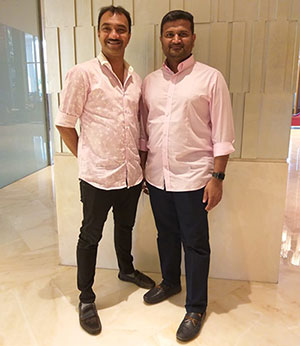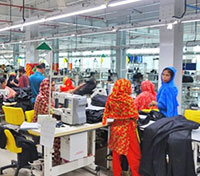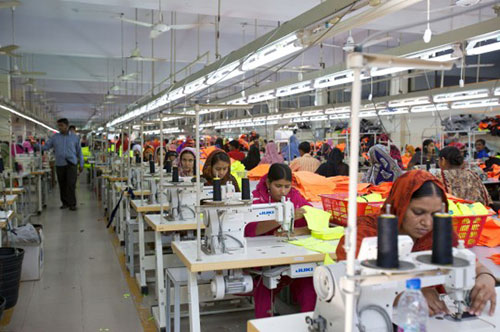FW
The Comprehensive and Progressive Agreement for Trans-Pacific Partnership (CPTPP) will allow Vietnam to increase exports of garments, footwear, timber products, and beverages to other member countries.
As of now, Vietnam’s exports of footwear, garment and textile, timber products, and beverages to CPTPP member countries make up 12.5 per cent, 16.04 per cent, 20 per cent and 23.46 per cent of its total exports. Japan, Malaysia, Singapore, Australia, New Zealand and Chile have bilateral or multilateral trade agreements with the country. Canada, Mexico and Peru are countries that Vietnam does not have free trade agreements with. So the CPTPP offers great opportunities for Vietnamese firms to access these markets through preferential tariffs.
But Vietnamese enterprises’ ability to take advantage depends on their preparation. To capitalise on the opportunities, the products must meet the CPTPP’s rules of origin and conform with sanitary and phytosanitary requirements and technical barriers to trade. Failure to meet these requirements would mean Vietnam cannot utilise the preferential tariffs offered by CPTPP member countries. Vietnamese garment and textile firms have faced difficulty in meeting the CPTPP’s rules of origin since their raw material imports from countries outside the CPTPP remain high. Domestic and foreign firms are now investing in the underdeveloped textile, dyeing and fabric segments to increase the domestic content rate.
By 2022 the Philippines hopes to be among the top 20 garment exporters in the world and have an annual growth of 12.3 per cent in garment exports and a three to five per cent increase in textile exports. This is expected to be possible with an increase in the utilization of natural and synthetic textile fiber by five per cent to ten per cent.
By 2025, the country wants to be among the top 15 garment exporters, with a 21.7 per cent annual increase in garments and a 10 per cent increase in natural and synthetic textile fiber. Infrastructure gaps and logistical bottlenecks will be addressed. Production, communication, distribution and transport will be made efficient through high-quality infrastructure and logistical services. Export market diversification will be pursued with more bilateral free trade agreements with emerging markets to reduce dependency on the US and EU markets. By 2029, the Philippines hopes to be among the top 10 of the world’s biggest garment exporters.
The industry has already upgraded to original brand manufacturer with homegrown Filipino labels and the textile manufacturing can fully support garment producers by offering a more diverse range of products both for the local and export markets.
 Formed around 15-16 years ago, the Fabric Suppliers Association provides fabric players with a platform to showcase their products. It also enables its members to exchange data and references. This is mainly achieved through the two fairs that the association organises every year. These fairs attract 1,000-1,500 visitors in a span of two days. They also enable FSA to add 25 to 30 new members every year. Amit from Mica Lifestyle and Sanjay Gala from Y2K Fashions elaborate on these fairs, the association and its future plans.
Formed around 15-16 years ago, the Fabric Suppliers Association provides fabric players with a platform to showcase their products. It also enables its members to exchange data and references. This is mainly achieved through the two fairs that the association organises every year. These fairs attract 1,000-1,500 visitors in a span of two days. They also enable FSA to add 25 to 30 new members every year. Amit from Mica Lifestyle and Sanjay Gala from Y2K Fashions elaborate on these fairs, the association and its future plans.
How long have you been involved with FSA? How has the association evolved over these years?
Amit: I have been involved with this association for the last two years. During this period, the association has become more mature, professional and modernised. Its recent shifting of its fair venue to Hotel Taj is quite a positive move.
The association has been growing steadily since the last few years. What are major factors contributing to this growth?
Sanjay: This association has enabled us to form a strong bond with our customers. The two fairs that it organises every year enable our customers to meet all their suppliers under a single roof. These fairs also give our customers a complete overview of the products available in the market. During the first edition of this fair, the association had only 45 members. Today, its member base has extended to around 100. Of these, 80-85 members are participating in the current edition of the fair.
How do you deal with your defaulters?
Sanjay: We have an action committee which resolves around 90 per cent of such cases. We have also prepared a list of defaulters to make our customers aware of them
What are your future plans? How do you see this association growing?
Amit: Every year, the association organises two fairs in Mumbai; the summer and winter editions. If we follow a similar pattern in all other states, we can help smaller clients to come together under single roof. This association also helps us to add members from other Indian cities. We plan to add members from 2-3 new cities every year. These clients will be added state-wise and zone-wise
What are your expectations from this association?
Sanjay: FSA has a strong association with CMAI with most of its members being our clients. Its committee members are putting in a lot of efforts to take the association to a higher level. We plan to introduce new initiatives for its growth in future.
Amit: We believe that adding more members from the textile and fabric segments will make FSA stronger. Right now, the association has 100 members. We plan to increase this to 200 in future.
What are your expectations from the upcoming fair?
Amit: We aim to add new members by sending their invitations in advance. This will enable them to plan their participation better. Increase in the number of participants will also help this fair to generate more business. Exhibitors will benefit by adding more clients.
 Saurabh Patel, the Energy Minister of Gujarat inaugurated ITMACH India 2019 on December 5, 2019. The textile technology show is being hosted in Gandhinagar’s Helipad Exhibition Centre from December 05-08, 2019.
Saurabh Patel, the Energy Minister of Gujarat inaugurated ITMACH India 2019 on December 5, 2019. The textile technology show is being hosted in Gandhinagar’s Helipad Exhibition Centre from December 05-08, 2019.
The exhibition, organised by K & D ITMACH Expositions, helps the industry to adopt modern technology. The show offers an effective networking and business-matching platform to the industry.
According to Arvind Semlani, Director, K & D ITMACH Expositions, “The Indian textile industry has continuously invested in innovations and technology up-gradations as global opportunities open up. While the spinning sector is facing a challenging situation due to US-China trade war, it has also brought some new opportunities to weaving, knitting, dyeing, printing & wet processing and garment sectors. Global brands and retailers are looking for Indian suppliers with economy of scale plant with state-of-the-art process technology. Therefore, the Indian weaving, processing and garmenting sectors are still in investment mode and resource efficient technologies are much in demand.”
Patel visited several stalls at the show and encouraged entrepreneurs for their efforts. He was impressed by Picanol’s latest weaving machinery - AirjetOmniplus- i loom with Smartshed which is being demonstrated live with denim fabric and operates at production speed above 1000 rpm! P Kasiviswanathan, Director, Picanol explained the innovative features of this latest weaving machine, which is most suited to the Indian weaving sector.
He also visited the booth of India’s leading digital printing solutions company Stovec, Jay Instruments, True Colors, Reckon India,Rimtex,Itema Weaving, Staubli, Texfab among others.
"With the US increasing tariffs on Chinese goods to 25 per cent, Bangladesh’s overseas sales rose to a record $40.5 billion in the year ended June 30.The country now aims to double its exports to $72 billion by 2024. This includes the $41 billion clothing business that goes to China that will provide a fillip to its economy"
 The US-China trade war is creating new export opportunities for other South Asian nations like Bangladesh, Vietnam and Malaysia. For example, Bangladesh-based garment manufacturers like the Newage Group are getting inquiries from US retailers like Macy’s and Gap. Viyellatex Group forecasts its annual exports to the US to more than double to $25 million in the year that began July 1, 2019. About 30 per cent of the company’s clients, including PVH Corp, owner of American fashion labels Tommy Hilfiger and Calvin Klein from the US.
The US-China trade war is creating new export opportunities for other South Asian nations like Bangladesh, Vietnam and Malaysia. For example, Bangladesh-based garment manufacturers like the Newage Group are getting inquiries from US retailers like Macy’s and Gap. Viyellatex Group forecasts its annual exports to the US to more than double to $25 million in the year that began July 1, 2019. About 30 per cent of the company’s clients, including PVH Corp, owner of American fashion labels Tommy Hilfiger and Calvin Klein from the US.
With the US increasing tariffs on Chinese goods to 25 per cent, Bangladesh’s overseas sales rose to a record $40.5 billion in the year ended June 30.The country now aims to double its exports to $72 billion by 2024. This includes the $41 billion clothing business that goes to China that will provide a fillip to its economy.
An opportunity for Bangladesh and Vietnam
So far, Trump has not included finished clothing in the list of tariffs levied on Chinese products. However, if these tariffs are included in the next round, they will impact the Chinese textile industry badly. In a situation like this, Bangladesh and Vietnam will be obvious choices as the next manufacturing destinations as retailers with exposure to the US will move their production out of China. To tap rising demand, Newage has tied up with a Chinese investor to set up a $20 million garment factory in Kaliakoir on the outskirts of the capital Dhaka. The unit will start production in four months.
Infrastructure bottlenecks
However, there are several roadblocks for Bangladesh companies in winning orders from Western firms. Not only does the country need to improve its supply chain, but also modernise its garment factories build highways and reduce red tape at ports to lure more buyers. The central government has been initiating several infrastructure projects. It opened two four-lane bridges on the highway to the Chittagong Port in May and another bridge earlier in March, which reduced travel time to the nation’s main port by almost half. Though the government has also been accelerating highway construction, it still takes 168 hours for exporters in the nation to ship from Dhaka, while it takes just 23 hours in Shanghai.
According to Fahmida Khatun, executive director of Dhaka-based Centre for Policy Dialogue, Bangladeshi exporters also need to improve their productivity for which they need to go for technological upgrade and automation in the garment industry.
Elleti has joined forces with MYR to digitise the creative process and connect users, suppliers and final consumers through a digital platform. Starting from a selection of bold designs, entirely envisioned and developed with MYR software, Elleti worked to recreate its look and fit on six garments, manufacturing each piece according to its signature innovative and responsible approach. Featuring forefront machinery and cutting-edge processing solutions, this relies on a continuous research effort focused on granting high-quality products while increasingly reducing their knock-on effect on both workers and the environment. The result turns out to be very impactful and inspiring, with denim solutions which proved the mastery of the leading Italian company in the art of washing, cutting and stitching the iconic blue fabric, as well as the great support that MYR software provided in the development of the collections.
Highly specialised in laundry and garment-making services, Elleti offers a complete range of services that covers the entire denim production cycle, starting from the development phase consultancy to the finished product. Research, innovation and quality define a unique approach, with a strong focus on sustainability. The group is a point of reference for Europe and the Mediterranean area, based on eleven production plants located between Italy, Tunisia and Romania and a production capacity of 14 million garments per year.
Ethiopia is building up its potential to become the next textile and apparel supply base for the world. Ethiopia may be able to develop the sector more quickly than other countries have in the past because of technological advancement and lesson learning. Despite challenges like an erratic energy supply, cumbersome customs procedures, lack of backward linkages and insufficient skills, Ethiopia hopes to be one of the next textile manufacturing hubs of the world with its wide and young labor pool, growing market potential, advantageous trade agreements, and strategic position.
The country has set up an institute to strengthen the overall value chain and created a conducive investment climate for the sector. The country wants investment that generates inclusive growth without generating irreversible destruction to the environment and resulting in unsustainable development. A handbook guides investors on how to incorporate sustainable practices into their investment journey. It gives concrete guidance on which social and environmental regulations investors need to comply with, where to seek support and which additional sustainability measures can be implemented.
Chinese investment in Ethiopia makes up 60 per cent of the overall FDI in the country. Chinese investment has contributed to the growth of the sector through knowledge and technology transfer, closing local companies’ capital gap and opening up new markets.
The European driving apparel market is growing at a CAGR of 5.7 per cent. Stringent regulations to ensure improved road safety have been a primary driver of the market. The alarming rise in cases of road accidents has compelled countries to enforce stringer regulations. These would encourage the use of various protection gears, which in turn will boost the driving apparel market in Europe.
The driving apparel market in Europe has a highly fragmented vendor landscape. The top three companies in hold barely 27.4 per cent share of the market. This is indicative of the presence of several companies. Investment in product innovation is therefore considered a key strategy by market players to gain improved traction. Companies have aligned their strategies with technological shifts to continue offering robust solutions to their customers. Mergers and acquisitions are widely followed. Strategic collaborations are the most sought after as these allow companies to expand their product portfolio as well as their regional footprint.
By product type, protection gear has the maximum demand and has a 51.7 percent share of the European market in 2016. Based on vehicle type, the two-wheeler segment has a share of 52.5 per cent in the overall market. Germany has a 35.3 per cent share of the overall European driving apparel market.
Mango has set up a new logistics center in Spain. Approximately 600 people work six days a week at the highly automated facility, where around 400 operations are machine-driven, to process items for store deliveries. The 186,000 square meter facility can stock up to seven million hung garments and 20 million folded garments and accessories at the same time. By incorporating the latest automation technologies, the center can process 75,000 garments an hour. As soon as hung garments arrive at the facility they are unloaded onto one of nine automatic loading bays, which can process 27,000 garments an hour. Each bay is equipped with a classifier that separates the garments by size and style. They then travel along a 24-kilometer rail to be shipped out to stores or held in the warehouse. Mango’s hanging garment installation is one of the most automated in Europe.
On the opposite side of the logistics center are automatic loading docks that can process 1,000 boxes of folded garments and accessories an hour. The boxes are passed through a weighing and labeling area and identified with a tracking ID so they can be located at any time. Like the hung garment area, the folded garment warehouse prepares boxes to be either shipped or stored based on in-store sales information.
The Spanish fashion brand with digital transformation and data wants to deliver meaningful changes.
Hugo Boss is bolstering its online business. These efforts have not been in vain - the company’s global online sales in the final quarter of 2018 were up by double digits. Three-quarters of the marketing budget in the coming years will go to digital marketing and a key focus would be on expanding the company's presence in the relevant social networks. Hugo Boss is looking to quadruple last year’s e-commerce sales by 2022.
The German luxury fashion house is strongly committed to the Chinese market. China is a key driver of the company’s growth. The brand’s stores in major cities such as Beijing and Shanghai have been posting double-digit growth throughout the year. Some of the key factors behind Hugo Boss’ emphatic growth in China are its focus on integrating its digital and physical retail channels, increasing its presence on social media as well as partnering brands that resonate with the Chinese audience. While the brand’s high-end casual wear has traditionally been the most popular among Chinese consumers, there has been strong growth in the sales of formal wear, particularly Hugo Boss’ made-to-measure suits. When it comes to made-to-measure offerings, China accounts for more than 50 per cent of the brand’s global sales.












